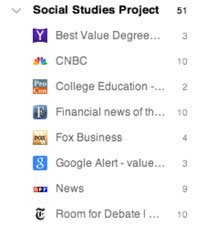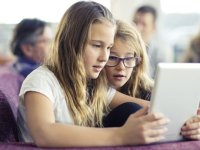Feeding Our Students’ Reading Interests with RSS
Anyone reading this post right now -- whether on your computer, tablet or smartphone -- knows that the interfaces for reading have indeed changed. Whereas just a decade ago, touchscreens were still a novelty, today they permeate our lives. And, according the Pew Internet Project, teens have a device ownership rate of 68 percent for smartphones and, overall, 91 percent for cell phones.
As devices proliferate, the amount of information we encounter each day grows. Despite their access to more substantive reading material, however, our students are most often consuming what journalist Clive Thompson calls "short form" writing -- status updates, tweets, text messages -- without digging into other texts.
How then, at a time when the Common Core asks students to "Analyze how two or more texts address similar themes or topics in order to build knowledge or to compare the approaches the authors take" (Anchor Standard CCSS.ELA-Literacy.CCRA.R.9), do we invite students to dig deeper, to find more substantive reading? To read critically, carefully and closely?
Edutopia writers have long promoted RSS, and it is time now that we apply some of our wisdom about how to develop PLNs to make RSS reading a regular part of our students' lives. You might enjoy watching the Common Craft's tutorial on RSS before we visit the fictionalized classroom of Mr. Cooper, a seventh grade social studies teacher.
Reading with RSS in Social Studies
Given his goal of engaging students in timely, relevant debates about economic topics such as the value of a college education or income inequality, Mr. Cooper works diligently to connect the study of American history to issues of finance. For Mr. Cooper, this is more than just bringing in an article for "current events" -- he wants his students to dig deeply into both sides of issues and to see multiple perspectives. Also, he is mindful that students should "Distinguish among fact, opinion and reasoned judgment in a text" (CCSS.ELA-Literacy.RH.6-8.8). So he has learners set up their Feedly accounts to bring in a variety of up-to-the-minute examples, straight out of the news media, as well as additional unbiased sources.
One student, Alisha, has been investigating the idea that a college education may not be worth her money and effort. For the past month, Mr. Cooper has been working with his students to set up a website (and smartphone/tablet app) called Feedly. Alisha has drawn in the financial RSS feeds from four major news media sources -- CNN, Fox News, CNBC and NPR. Also, Mr. Cooper has students subscribe to the New York Times' Room for Debate blog and the topic feed on ProCon.org. Today, he teaches them a mini lesson on how to set up an RSS feed using Google Alerts, and Alisha has used the terms "value college education" to come up with a customized feed of recent news. Additionally, she found Yahoo’s Education site, which didn't have an RSS feed, but she was able to use Feedity to generate one.

While she can view the feeds with related images, like a newspaper, Alisha snaps a screenshot of her Feedly page -- in list view -- to share with Mr. Cooper, demonstrating that she has found a wide variety of sources. As she attaches the picture to an email she is about to send him, she reflects on the process of setting up her feeds. "I know that there are tons of resources to help me decide on what kind of college degree to pick," she writes. "And keeping up on the news about the best value for my family's money is really important to me."
For Mr. Cooper, the value of having students create these personalized "living textbooks" is immediately apparent. By using RSS feeds to fuel their own interests and passions, reading a variety of sources about a financial topic, his learners make more personal connections to the study of economics.
As they bookmark resources over the course of the marking period, Mr. Cooper will invite his students to copy and paste relevant quotes from their reading into a Google Document -- along with citations -- so that he can help them shape their final, argumentative papers. This recursive process of reading new RSS feeds, selecting relevant information, writing about it, and then reading more continues throughout the unit.
Toward "Connected Reading"
In research that I have conducted with Kristen Hawley Turner, at Fordham University, we have discovered a variety of ways that students are -- and are not -- reading online. They often seek out information, skimming and scanning a variety of search results or trusted web portals such as Yahoo News. However, very few of them know about RSS or how it works. Given that RSS is the backbone of the mobile web, teaching our students to be engaged readers will require that we, as teachers, actively promote the kinds of practices that Mr. Cooper has taught his students. Also, we can invite students to share what they are reading within their peer network, asking for reactions from others so they can discuss what they have read.
We will report more findings from this research in a forthcoming book for the National Council of Teachers of English, which is tentatively titled Connected Reading: Teaching Adolescent Readers in a Digital World.
For now, I want to reiterate the power of RSS as a tool for active reading. Invite students to use a tool like Feedly, or other apps such as Flipboard, to create their own customized reading experiences, thereby supporting their autonomy and choice as readers.
What resources do your students use for critical reading?
